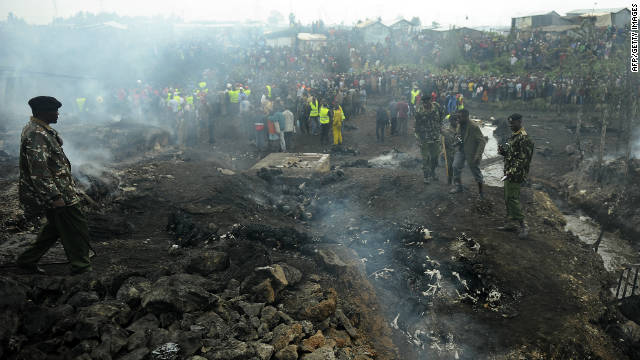
Blast victims burned beyond recognition
STORY HIGHLIGHTS
- The confirmed death toll rises to 75 after a Nairobi pipeline explosion
- The pipeline exploded Monday morning in the Sinai slum
- Police and Red Cross officials say the toll is likely to reach 100
- Residents discounted fire danger in 2009 Kenyan newspaper article
Survivors said a crowd gathered with jerry cans when oil from a nearby depot spilled into a sewage ditch.
The fire began without warning when a man tossed away a cigarette butt. The ensuing inferno engulfed dozens of men, women and children who had been frantically filling containers with oil, they said.
The impoverished Sinai district of Nairobi was a scene of hellish devastation on Monday. Charred bodies lay scattered up to 300 metres from the site of the blast, and police put a net across a river as more floated down.
Fires still burned, as locals watched the rescue operation and children in school uniforms searched desperately for missing parents.
"It was like a bomb," said Stephen Njau, 29, a carpenter who had been about 500 metres away when the first explosion rocked the area. "After the blast, manhole covers were thrown very high into the air. There were screams everywhere. I ran and ran."
Njau said the blast happened at 8.30am, just as hundreds of people were on their way to work. There were several loud explosions, he said, as the blaze ripped instantly through the densely packed tin-shacks, killing dozens of people.
Sammy Njenga, 21, said people had rushed to fill their jerry cans with free fuel before the explosion. "I was going to the loo down by the river just after 4am when I saw the gold flowing from the pipe. I ran home, grabbed two jerry cans and went back to fill them up. As I finished and turned away there was a boom as the fuel ignited."
He told Reuters: "I could feel the flames on my back and dropped one can so I could run further. But it spread so fast I dropped the other as well. I had been standing next to a mother of three who wasn't fast enough. She died."
Police said 61 people had been confirmed dead, but deputy spokesman Charles Owino added: "We are retrieving more." The Red Cross said it had recovered at least 75 charred bodies from the scene. Some 112 badly injured burns victims were taken to Kenyatta national hospital, according to its head, Richard Lesiyampe, and the death toll was likely to rise.
The slum, which is about three miles from Kenya's main international airport, is one of dozens of informal settlements where millions of Kenya's urban poor live in a nation marked by striking inequalities, despite Africa's biggest non-mineral economy. It is common for people in the slums to rush to the scene of oil spills to scoop up petrol or diesel, which they sell for small amounts of money in the black market. In 2009, 122 died in western Kenya after fire erupted while they were drawing fuel from an overturned tanker. But disasters on this scale are rare.
Government officials struggled to find a coherent response to the tragedy. Kenya's prime minister, Raila Odinga, visited the scene and pledged help for the victims. "The government will do everything possible to ensure the injured will be treated and the families who have lost their loved ones will be compensated," he said, standing in the sun roof of his 4x4 vehicle. "It's unfair for people to die like this."
President Mwai Kibaki visited patients at the country's largest public hospital.
In the heart of the slum, emergency response crews found charred bodies piled up to six deep. Many at the seat of the blast had been overwhelmed despite diving for safety into the nearby Nairobi river. Several hours after the blast, their bodies lay, uncovered, in the dark brown waters of the river.
Residents around the disaster zone offered a familiar lament over official neglect of the Kenyan capital's slum dwellers. "There is no government here," said Stephen Njaramba, a 30-year-old businessman who runs a mobile money transfer service in Sinai. "If there was an official presence, the authorities would have noticed that the spillage had been going on for several hours before the blast and stopped it. But we are left to live like this with no services, access roads or security. This is very painful."
Horrified residents gathered on the banks of the river to watch the bodies being recovered. Almost all the victims were reduced to charcoal skeletal remains, many piled on top of each other at the points in the river where they had dived in to try to get away from the flames.
As firemen pulled body after body from the razed iron shacks, witnesses attempted to guess identities.
"That one is very tall, he may be the guy from the village across there," one young man offered. At the sight of a particularly small skeletal figure, one person asked: "Is that a baby?" No, came the reply, probably a cat.
The fire that consumed the slum highlighted the squalid living conditions for many in that settlement, which sprang up to serve the city's industrial area. Rescue workers had to dodge hanging wires that bring illegal power to the tin shacks. Residents cannot afford electricity, but most have a television aerial jutting above their homes, powered by the thriving underground economy.
Many interviewed said the disaster could have been averted if government agencies had not all but abandoned the area.
"Here it is every man for himself," said Washington Ouma, a 23-year-old casual worker. "If police on patrol ventured here, they would have noticed that people had been scooping oil for nearly 12 hours and would have stopped it."
